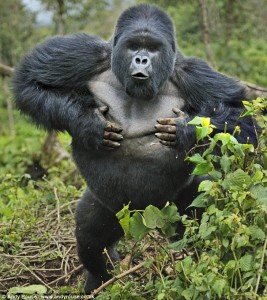There are numerous studies that support that non-human primates, who are of closest relation to humans are able to gesture as part of their communication systems. The pioneering studies of Goodall (1986) and Kummer (1968) observed different gestures used by monkeys and apes.
The studies of gestural communication in apes both in captivity and in the wild reveal the following:
- The use of communicative gestures is common across the species,
- There is considerable variability in gesture repertoire from group to group,
- Gestures are used flexibly in different contexts, depending on the behavior of the recipient.
Gesturing by primates is argued to be partially genetic, with apes performing gestures that are characteristic of their species even without prior observation of the gesture. An evidence of this is the “chest beat”, a display of threat, being performed by two gorillas that have not witnessed the performance of this gesture before (Redshaw & Locke, 1976). Similarly, chimpanzees from peer groups that essentially had no opportunity to observe older conspecific develop many of the same play gestures performed by individuals from a more natural group composition (Berdecio & Nash, 1981). Hence, the Gestural Theory suggests the importance and intrinsicality of gestures in primate communication, holding that gestures were the precursors to language and communication.

